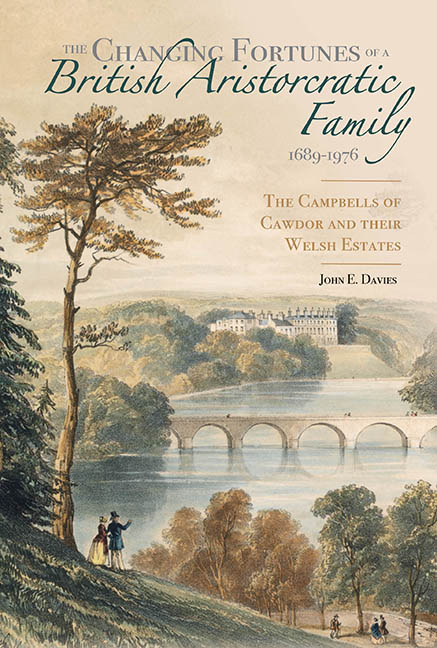 The Changing Fortunes of a British Aristocratic Family, 1689–1976
The Changing Fortunes of a British Aristocratic Family, 1689–1976 Book contents
- Frontmatter
- Contents
- List of Illustrations
- Acknowledgements
- List of Abbreviations
- Pedigree
- Introduction
- 1 Cawdor and Campbell
- 2 Estate Administration
- 3 The Agricultural Estate: The Cawdors as Farmers and Landlords
- 4 The Cawdors as Industrial Landowners
- 5 The Cawdors in the Community: Church and Education
- 6 The Mêlée of Local Governance
- 7 The Cawdors in Politics: Interest Building, Consolidation and Decline
- 8 Private and Exclusive Lives
- 9 The End of the Welsh Estates
- Conclusion
- Bibliography
- Index
- Frontmatter
- Contents
- List of Illustrations
- Acknowledgements
- List of Abbreviations
- Pedigree
- Introduction
- 1 Cawdor and Campbell
- 2 Estate Administration
- 3 The Agricultural Estate: The Cawdors as Farmers and Landlords
- 4 The Cawdors as Industrial Landowners
- 5 The Cawdors in the Community: Church and Education
- 6 The Mêlée of Local Governance
- 7 The Cawdors in Politics: Interest Building, Consolidation and Decline
- 8 Private and Exclusive Lives
- 9 The End of the Welsh Estates
- Conclusion
- Bibliography
- Index
Summary
Cawdor Castle, the ancestral home of the thanes of Cawdor, lies five miles south of Nairn and is the centre of an estate covering about a third of the old county of Nairnshire. The estate prides itself on organic farming as it exploits the fertile lands bordering part of the Moray Firth. To the south of the castle moorland increasingly takes the place of farmland and grouse-shooting draws to Cawdor many visitors hoping to experience the ‘Highlands’. The estate is thus one of great contrasts. It was developed and expanded by the thanes of Cawdor from the thirteenth century and reached its zenith in the early seventeenth century, when the estate was granted the whole of Islay. However, the seemingly never-ending localised wrangling amongst – and within – the clans, the grinding economic poverty of the Highlands and its extreme remoteness were ultimately massive stumbling blocks to any further advancements the family desired. The union of the two kingdoms at the beginning of the seventeenth century, followed by dynastic change in 1688 and political union in 1707, all emphasised the importance of London as the centre of politics for anyone, Scots included, hungry for power. After 1688 Scotland seemed to be disintegrating once more into sectarian strife, while politically the Scottish parliament, for decades no more than a nodding shop to the king, had become, at least temporarily, totally moribund. For the Campbells of Cawdor, a mixture of political expediency, political ambition garnered with opportunism, and a desperate shortage of cash stimulated them to look south of the border for their future advancement. A year after the Glorious Revolution, the Cawdors had, for the first time, married outside Scotland: Alexander's marriage to Elizabeth Lort of Stackpole was symbolic of the Cawdors’ increasing estrangement from their ancestral home and Scottish politics. The Cawdor estate was left to be administered by relatives and Edinburgh lawyers as the Campbells of Cawdor pursued advancement, both economic and political, in Wales and London. Alexander's son, John, never visited Cawdor, and his grandson, the first baron Cawdor, only visited on rare occasions. In 1810 alienation from the Scottish estate was further emphasised when the whole of the estate was leased in a bid to raise money to placate numerous creditors.
- Type
- Chapter
- Information
- The Changing Fortunes of a British Aristocratic Family, 1689–1976The Campbells of Cawdor and their Welsh Estates, pp. 1 - 8Publisher: Boydell & BrewerPrint publication year: 2020
